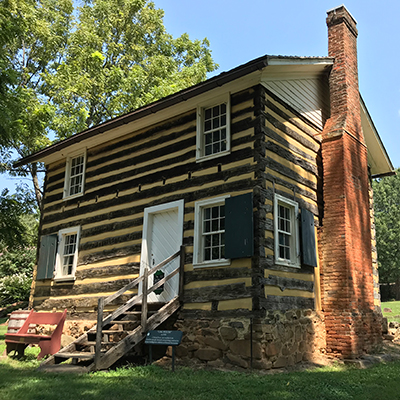The Log House
1754 Reconstructed Village | The Palisade | The Log House | The Brewer’s House | The Potter’s House | The Gemeinhaus
 The Log House is significant because it represents the development of Bethabara during the nineteenth and twentieth centuries.
The Log House is significant because it represents the development of Bethabara during the nineteenth and twentieth centuries.
During the archaeological excavations of the 1960s, the historic homes and businesses of “Old Town,” the 19th Century rural town which had grown up and around colonial Bethabara, were demolished to accommodate the “restoration” of Bethabara’s colonial appearance. Demolition to achieve the appearance of a particular period of significance was a common practice in the 20th century. Today, that practice has fallen out of favor for a more holistic approach to interpreting the historic landscape.
The so-called Pough house, named for the R.W. Pough family, the last inhabitants before the land was sold to the Southern Province of the Moravian Church in 1964, was a small clapboard Victorian house, complete with porch and gingerbread wood working. Slated for demolition, archaeologist Stan South removed the siding and found a log house underneath. With that discovery, research into the history of this structure commenced.
Originally believed to be constructed in 1816 (later dendrochronology proved its 1834 construction date), the Log House stands almost directly on top of an older (ca. 1759) “family house in the cow-yard.” Likely a one-and-a-half to two-story house, it may have undergone several periods of building and alteration, with weatherboarding introduced in the mid-nineteenth century.
The rear wing of the Log house was removed by archeologist Stanley South in 1965 in order to allow for archaeological excavation of the 1759 foundations. That dig revealed some of the ruins of the “family house.” In the 1970s and 80s, the Log House underwent restoration under the aegis of the Bethabara Historical Society. The front porch and weatherboard siding were removed and in 1976 the Bethabara Historical Society began chinking the building. The 1950’s metal roof was removed and replaced with hand-rived cedar shakes.
In 2010 the Historic Bethabara Park, Inc. Board of Trustees enlisted the services of Wilson Covington Construction to re-chink deteriorating sections of the exterior walls and the interior of the building. The floor was repaired and sections were replaced as needed. In 2013 the Trustees hired Michael Worthington of Oxford Tree-Ring Laboratory to conduct dendrochronological analysis (tree ring dating) to determine the date the original structure was built. Worthington’s studies indicate that the Log House was constructed with trees felled in 1833-34.
The Log House is significant because it survives as a rare representative of the development of Bethabara during the 19th and 20th centuries. The Log House was listed in the National Register of Historic Places in 1978 as part of the Bethabara Historic District.
